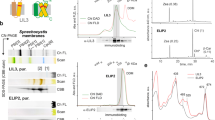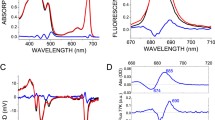Abstract
Photoprotection of the chloroplast is an important component of abiotic stress resistance in plants. Carotenoids have a central role in photoprotection. We review here the recent evidence, derived mainly from in vitro reconstitution of recombinant Lhc proteins with different carotenoids and from carotenoid biosynthesis mutants, for the existence of different mechanisms of photoprotection and regulation based on xanthophyll binding to Lhc proteins into multiple sites and the exchange of chromophores between different Lhc proteins during exposure of plants to high light stress and the operation of the xanthophyll cycle. The use of recombinant Lhc proteins has revealed up to four binding sites in members of Lhc families with distinct selectivity for xanthophyll species which are here hypothesised to have different functions. Site L1 is selective for lutein and is here proposed to be essential for catalysing the protection from singlet oxygen by quenching chlorophyll triplets. Site L2 and N1 are here proposed to act as allosteric sites involved in the regulation of chlorophyll singlet excited states by exchanging ligand during the operation of the xanthophyll cycle. Site V1 of the major antenna complex LHC II is here hypothesised to be a deposit for readily available substrate for violaxanthin de-epoxidase rather than a light harvesting pigment. Moreover, xanthophylls bound to Lhc proteins can be released into the lipid bilayer where they contribute to the scavenging of reactive oxygen species produced in excess light.
Similar content being viewed by others
References
Bassi R, Soen SY, Frank G, Zuber H and Rochaix JD (1992) Characterization of chlorophyll a/b proteins of Photosystem I from Chlamydomonas reinhardtii. J Biol Chem 267: 25714–25721
Bassi R, Pineau B, Dainese P and Marquardt J (1993) Carotenoid binding proteins of Photosystem II. Eur J Biochem 212: 297–303
Bassi R, Croce R, Cugini D and Sandonà D (1999) Mutation analysis of an higher plant antenna protein provides identification of chromophores bound into multiple sites. Proc Natl Acad Sci USA 96: 10056–10061
Bungard RA, Ruban AV, Hibberd JM, Press MC, Horton P and Scholes JD (1999) Unusual carotenoid composition and a new type of xanthophyll cycle in plants. Proc Natl Acad Sci USA 96: 1135–1139
Cinque G, Croce R, Holzwarth A and Bassi R (2000) Energy transfer among CP29 chlorophylls: calculated Förster rates and experimental transient absorption at room temperature. Biophys J 79: 1706–1717
Connelly JP, Muller MG, Bassi R, Croce R and Holzwarth AR (1997) Femtosecond absorption study of carotenoid to chlorophyll energy transfer in the light harvesting complex II of Photosystem II. Biochemistry 36: 281–287
Crimi M, Dorra D, Bosinger CS, Giuffra E, Bassi R and Holzwarth AR (1998) Zeaxanthin-induced fluorescence quenching in the minor antenna CP29. In: Garab G (ed) Photosynthesis: Mechanisms and effects, Vol 1, pp 333–336. Kluwer Academic Publishers, Dordrecht/Boston/London
Crimi M, Dorra D, Bösinger C, Giuffra E, Bassi R and Holzwarth AR (2000) Fluorescence lifetime analysis of the recombinant Photosystem II antenna complex CP29. Effects of zeaxanthin, pH and phosphorylation. Eur J Biochemistry (in press)
Croce R and Bassi R (1998) The light harvesting complex of Photosystem I: Pigment composition and stoichiometry. In: Garab G (ed) Photosynthesis: mechanisms and effects, Vol 1, pp 421–424. Kluwer Academic Publishers, Dordrecht/Boston/London
Croce R, Remelli R, Varotto C, Breton J and Bassi R (1999a) The neoxanthin binding site of the major light harvesting complex (LHC II) from higher plants. FEBS Lett 456: 1–6
Croce R, Weiss S and Bassi R (1999b) Carotenoid binding sites of the major light harvesting complex (LHC II) of higher plants. J Biol Chem 274: 29613–29623
Crofts AR and Yerkes CT (1994) A molecular mechanism for qEquenching. FEBS Lett 352: 265–270
Dmitriev O, Jones PC, Jiang W and Fillingame RH (1999) Structure of the membrane domain of subunit b of the Escherichia coli F0F1 ATP synthase. J Biol Chem 274: 15598–15604
Frank HA, Cua A, Chynwat V, Young A, Gosztola D and Wasielewski MR (1994) Photophysics of the carotenoids associated with the xanthophyll cycle in photosynthesis. Photosynth Res 41: 389–395
Frank HA, Bautista JA, Josue JS and Young AJ (2000a) Mechanism of nonphotochemical quenching in green plants: energies of the lowest excited singlet states of violaxanthin and zeaxanthin. Biochemistry 39: 2831–2837
Frank HA, Das SK, Bautista, JA, Gosztola D, Wasielewski MR, Crimi M, Croce R and Bassi R (2000b) The photochemical behaviour of xanthophylls in the recombinant Photosystem II antenna complex CP26. Biochemistry (in press)
Funk C, Adamska I, Green BR, Andersson B and Renger G (1995) The nuclear-encoded chlorophyll-binding Photosystem II-S protein is stable in the absence of pigments. J Biol Chem 270: 30141–30147
Gilmore AM, Hazlett TL and Govindjee (1995) Xanthophyll cycle dependent quenching of Photosystem II chlorophyll a fluorescence: formation of a quenching complex with a short lifetime. Proc Natl Acad Sci USA 92: 2273–2277
Havaux M and Niyogi KK (1999) The violaxanthin cycle protects plants from photooxidative damage by more than one mechanism. Proc Natl Acad Sci USA 96: 8762–8767
Hobe S, Niemeier H, Bender A and Paulsen H (2000) Carotenoid binding sites in LHC IIb. Relative affinities towards major xanthophylls of higher plants. Eur J Biochem 267: 616–624
Horton P, Ruban AV and Walters RG (1996) Regulation of light harvesting in green plants. Annu Rev Plant Physiol Plant Mol Biol 47: 655–684
Jansson S (1999) A guide to the Lhc genes and their relatives in Arabidopsis. Trends in Plant Sci 4: 236–240
Jegershoeld C, Rutherford AW, Mattioli TA, Crimi m and Bassi R (2000) Calcium binding to the Photosystem II subunit CP29. J Biol Chem 275: 12781–12788
Kühlbrandt W, Wang DN and Fujiyoshi Y (1994) Atomic model of plant light-harvesting complex by electron crystallography. Nature 367: 614–621
Li XP, Bjorkman O, Shih C, Grossman AR, Rosenquist M, Jansson S and Niyogi KK (2000) A pigment-binding protein essential for regulation of photosynthetic light harvesting. Nature 403: 391–395
Niyogi KK (1999) Photoprotection revisited: genetic and molecular approaches. Ann Rev Plant Physiol Plant Mol Biol 50: 333–359
Niyogi KK, Bjorkman O and Grossman AR (1997) The roles of specific xanthophylls in photoprotection. Proc Natl Acad Sci USA 94: 14162–14167
Niyogi KK, Grossman AR and Bjorkman O (1998) Arabidopsis mutants define a central role for the xanthophyll cycle in the regulation of photosynthetic energy conversion. Plant Cell 10: 1121–1134
Pålsson LO, Tjus SE, Andersson B and Gillbro T (1995) Ultrafast energy transfer dynamics resolved in isolated spinach light harvesting complex I and the LHC I-730 subpopulation. Biochim Biophys Acta 1230: 1–9
Pesaresi P, Sandonà D, Giuffra E and Bassi R (1997) A single point mutation (E166Q) prevents dicyclohexylcarbodiimide binding to the Photosystem II subunit CP29. FEBS Lett 402: 151–156
Polívka T, Herek JL, Zigmantas D, Akerlund HE and Sundström V (1999) Direct observation of the (forbidden) S1 state in carotenoids. Proc Natl Acad Sci USA 96: 4914–4917
Remelli R, Varotto C, Sandonà D, Croce R and Bassi R(1999) Chlorophyll binding to monomeric light-harvesting complex. A mutation analysis of chromophore-binding residues. J Biol Chem 274: 33510–33521
Rock CD and Zeevaart JAD (1991) The aba mutant of Arabidopsis thaliana is impaired in epoxy-carotenoid biosynthesis. Proc Natl Acad Sci USA 88: 7496–7499
Ros F, Bassi R and Paulsen H (1998) Pigment-binding properties of the recombinant Photosystem II subunit CP26 reconstituted in vitro. Eur J Biochem 253: 653–658
Ruban AV, Young AJ, Pascal AA and Horton P (1994) The effects of illumination on the xanthophyll composition of the Photosystem II light harvesting complexes of spinach thylakoid membranes. Plant Physiol 104: 227–234
Ruban AV, Phillip D, Young AJ and Horton P (1998) Excited state energy level does not determine the differential effect of violaxanthin and zeaxanthin on chlorophyll fluorescence quenching in the isolated light-harvesting complex of Photosystem II. Photochemistry & Photobiology 68: 829–834
Ruban AV, Lee PJ, Wentworth M, Young AJ and Horton P (1999) Determination of the stoichiometry and strength of binding of xanthophylls to the Photosystem II light harvesting complexes. J Biol Chem 274: 10458–10465
Schmid VHR, Cammarata KV, Bruns BU and Schmidt GW (1997) In vitro reconstitution of the Photosystem I light-harvesting complex LHC I-730: Heterodimerization is required for antenna pigment organization. Proc Natl Acad Sci USA 94: 7667–7672
Verhoeven AS, Adams III WW, Demmig-Adams B, Croce R and Bassi R (1999) Xanthophyll cycle pigment localization and dynamics during exposure to low temperatures and light stress in low and high light-acclimated Vinca major. Plant Physiol 120: 1–11
Walla PJ, Yom J, Krueger BP and Fleming GR (2000) Two-photon excitation spectrum of light harvesting complex II and fluorescence upconversion after one-or two-photon excitation of the carotenoids. J Phys Chem 104: 4799–4806
Wentworth M, Ruban AV and Horton P (2000) Chlorophyll fluorescence quenching in isolated light harvesting complexes induced by zeaxanthin. FEBS Lett 471: 71–74
Yamamoto HY and Bassi R (1996) Carotenoids: Localization and function. In: Ort DR and Yokum CF (eds) Advances in Photosynthesis. Oxygenic Photosynthesis: The light reactions, pp 539–563. Kluwer Academic Publishers, Dordrecht, The Netherlands
Author information
Authors and Affiliations
Corresponding author
Rights and permissions
About this article
Cite this article
Bassi, R., Caffarri, S. Lhc proteins and the regulation of photosynthetic light harvesting function by xanthophylls. Photosynthesis Research 64, 243–256 (2000). https://doi.org/10.1023/A:1006409506272
Issue Date:
DOI: https://doi.org/10.1023/A:1006409506272




